History
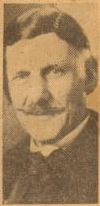
 Ian Holbourn born John Bernard Stoughton Holbourn on November 5, 1872, to Alfred Holborn and Mary Jane Stoughton. John Bernard, who later went by Ian, which is the Scottish version of John, was the eldest of their two children. His mother died when he was very young and due to his father’s ill health, the children were sent to live with their stern Aunt Augusta. As a young man he became fond of the remote Scottish island of Foula, which he succeeded in purchasing around 1900, thus becoming its laird (owner of a large, long-established Scottish estate). He was also a professor and lecturer for the University of Oxford, and a writer.
Ian Holbourn born John Bernard Stoughton Holbourn on November 5, 1872, to Alfred Holborn and Mary Jane Stoughton. John Bernard, who later went by Ian, which is the Scottish version of John, was the eldest of their two children. His mother died when he was very young and due to his father’s ill health, the children were sent to live with their stern Aunt Augusta. As a young man he became fond of the remote Scottish island of Foula, which he succeeded in purchasing around 1900, thus becoming its laird (owner of a large, long-established Scottish estate). He was also a professor and lecturer for the University of Oxford, and a writer.
Avis Gertrude Dolphin was born on August 24, 1902, in Rotherham, Yorkshire, England to John Henry Dolphin and Alice Schofield Dolphin. Avis as twelve years old when her parents booked passage for her and two nurses, Sarah Smith and Hilda Ellis, on RMS Lusitania, bound for England where Avis was to attend school while living with her grandparents. It was on that voyage that Ian Holbourn and Avis Dolphin would cross paths and their lives would be forever changed.
Ian befriended the young girl, who seemed to need a friend at the time. They talked of many things from the journey they were on to her upcoming school. She told Ian in one of their talks, that books for girls were uninteresting. Ian, an author, wrote his book “The Child of the Moat, A Story for Girls, 1557 A.D.” for Avis in 1916. The two would be friends for the rest of Ian’s life, but only because they were both destined to survive the sinking of the ship they met on. RMS Lusitania was hit by a torpedo launched from a German U-boat on May 7, 1915. That afternoon, RMS Lusitania was 11 miles off the southern coast of Ireland inside the declared war zone. The torpedo triggered in internal explosion. The damage caused her to sink in 18 minutes, killing 1,197 passengers and crew. Eventually, 289 bodies were recovered or found from the wreck. Only 761 people survived, among them, Avis Dolphin and Ian Holbourn. Ian was married to Marion Constance Archer-Shepherd, 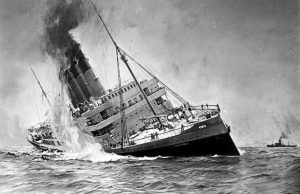
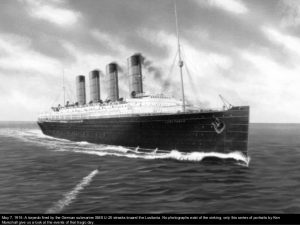 and together they had three sons. Ian died on September 15, 1935. Avis was introduced to journalist Thomas Foley during a visit to Holbourn’s home, and the two were married in 1926. Avis lived the remainder of her life in Snowdonia, Wales and died of natural causes in Meirionydd, which is a coastal and mountainous region of Wales, at the age of 93 on February 5, 1996.
and together they had three sons. Ian died on September 15, 1935. Avis was introduced to journalist Thomas Foley during a visit to Holbourn’s home, and the two were married in 1926. Avis lived the remainder of her life in Snowdonia, Wales and died of natural causes in Meirionydd, which is a coastal and mountainous region of Wales, at the age of 93 on February 5, 1996.

 World records come and world records go. Some take longer to beat than others. One record had stood for nine years. It was a record involving human endurance, and after a while, many believed that the recorded for the four-minute mile seemed like it just couldn’t be broken. so many athletes had tried and failed to break the record of 4 minutes 1.3 seconds set by Gunder Hagg of Sweden in 1945. Nevertheless, a hard to break record is a great motivator, and this one drew lots of athletes who were determined to break that record.
World records come and world records go. Some take longer to beat than others. One record had stood for nine years. It was a record involving human endurance, and after a while, many believed that the recorded for the four-minute mile seemed like it just couldn’t be broken. so many athletes had tried and failed to break the record of 4 minutes 1.3 seconds set by Gunder Hagg of Sweden in 1945. Nevertheless, a hard to break record is a great motivator, and this one drew lots of athletes who were determined to break that record.
By the early 1950s, and because so many athletes had tried and failed to run a mile in less than four minutes, people began to believe that it was a physical, and maybe even a phycological impossibility. Still, that seldom stops people from trying. In fact, in the early 1950s, several runners had dedicated themselves to being the first to cross into the three-minute zone. The goal became such a big deal that the crowds actually held their breath waiting for the time on a run to be announced. I’m sure that each failure was a colossal disappointment.
On May 6, 1954, in Oxford, England, 25-year-old medical student Roger Bannister finally succeeded in breaking track and field’s most notorious barrier…the four-minute mile. Bannister, who was born in Harrow, England, in 1929, was a top mile-runner while a student at the University of Oxford and at Saint Mary’s Hospital Medical School in London. He won British championships in the mile run, in 1951 and 1953. As he prepared himself for his first competitive race of the 1954 season, Bannister researched the mechanics of running and trained using new scientific methods he developed through his research.
Bannister came to the Iffley Road track in Oxford on May 6, 1954, for the annual match between the Amateur Athletic Association and Oxford University. Bannister was running for the Amateur Athletic Association and against his alma mater, Oxford University. The conditions that day were far from ideal. It had been windy and raining, and a considerable crosswind was still blowing across the track as the mile race was set to begin. At precisely 6pm, the starting gun was fired. Bannister had planned the race very carefully. He was aided by Chris Brasher, a former Cambridge runner who acted as a pacemaker. For the first half-mile, Brasher led the field, with Bannister a close second. Then, another runner took up the lead and reached the three-quarter-mile mark in 3 minutes .4 seconds. Bannister passed the mark at 3 minutes .7 seconds. Then, as he had planned, Bannister took the lead with about 350 yards to go and sprinted past an unofficial timekeeper at the 1,500-meter mark in 3 minutes 43 seconds, thus equaling the world’s record for that distance. Then, Bannister poured it on, throwing in all his reserves. When he broke the tape the time was 3 minutes 59.4 seconds. The announcer didn’t even get the whole time out before the crown erupted. All they needed to hear was “three minutes.” The rest didn’t matter, because the record had been broken!! Bannister’s official time was 3 minutes 59.4 seconds. It was very close to the 4-minute mark, but that didn’t matter, because .6 seconds still made it under four minutes. As soon as the first part of his score was the crown went wild!!
Bannister went on to win British and Empire championships in the mile run, and the European title in the 1,500-meter event in 1954. That was all it took for him. Going out on top, Bannister retired from athletic competition at the end of 1954, to pursue his medical career full time. He wrote a book about his experience in 1955, called The Four Minute Mile. Bannister went on to earn a medical degree from Oxford and became a neurologist. In 1955, Bannister married the Swedish artist Moyra Elver Jacobsson in Basel, Switzerland. Together they had four children…Carol Bannister (born 1957), Clive Bannister (born 1959), Thurstan Bannister (born 1960), and Charlotte Bannister (born 1963). In 1975, he was knighted by Queen Elizabeth II. He died of pneumonia at the John Radcliffe Hospital in Oxford on March 3, 2018.
As for his world record in the mile, well it did not stand long. The record continued to be lowered with 
 increasingly controlled climatic and surface conditions, more accurate timing devices, and improvements in training and running techniques. A “sub-four” mile run is still a notable time, but top international runners now routinely accomplish the feat. These days, the “mile race” has been replaced in the Olympics, because the mile is not a metric measurement. Nevertheless, it continues to be run by many top runners as a glamour event. While the sub-four race time is now a rather common time for the mile, no one else can claim the first-time record, because that belongs exclusively to Roger Bannister.
increasingly controlled climatic and surface conditions, more accurate timing devices, and improvements in training and running techniques. A “sub-four” mile run is still a notable time, but top international runners now routinely accomplish the feat. These days, the “mile race” has been replaced in the Olympics, because the mile is not a metric measurement. Nevertheless, it continues to be run by many top runners as a glamour event. While the sub-four race time is now a rather common time for the mile, no one else can claim the first-time record, because that belongs exclusively to Roger Bannister.
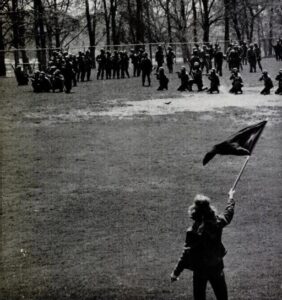 The Vietnam War was a volatile time in American history. When the war started, so did the draft. Many people protested, especially students. I suppose for them, it all felt so much closer to home, than for the older Americans. Still, the students were not alone in protesting. Many Americans agreed and protested too. The law allows for “peaceful” protesting, saying that it is “a constitutionally protected form of expression under the First Amendment in the United States. It falls under the right to free assembly, allowing every American to voice their opinions and advocate for change. However, a protest becomes a riot when one or more people within the group engage in criminal activity. This can include intentionally damaging property or causing physical harm to another person1. In other words, when a peaceful demonstration loses control and turns violent, it transitions from a protest to a riot.”
The Vietnam War was a volatile time in American history. When the war started, so did the draft. Many people protested, especially students. I suppose for them, it all felt so much closer to home, than for the older Americans. Still, the students were not alone in protesting. Many Americans agreed and protested too. The law allows for “peaceful” protesting, saying that it is “a constitutionally protected form of expression under the First Amendment in the United States. It falls under the right to free assembly, allowing every American to voice their opinions and advocate for change. However, a protest becomes a riot when one or more people within the group engage in criminal activity. This can include intentionally damaging property or causing physical harm to another person1. In other words, when a peaceful demonstration loses control and turns violent, it transitions from a protest to a riot.”
On May 2, 1970, a protest rally at Kent State University resulted in the National Guard troops being called out to suppress students who were now rioting in protest of the Vietnam War and the US invasion of Cambodia. As scattered protests continued the next day, they were dispersed by tear gas, and on May 4th class resumed at Kent State University. University officials put a ban of rallies, but it didn’t stop the rallies. By noon, some 2,000 people had assembled on the campus. The National Guard troops arrived and ordered the crowd to disperse, fired tear gas, and advanced against the students with bayonets fixed on their rifles. As is common among protesters, some refused to disperse, and even responded by throwing rocks and verbally taunting the troops.
As the situation escalated, and without firing a warning shot, 28 Guardsmen discharged more than 60 rounds  toward a group of demonstrators in a nearby parking lot, killing four and wounding nine, one of whom would be permanently paralyzed. The closest casualty was 20 yards away, and the farthest was almost 250 yards away. After a period of disbelief, shock, and attempts at first aid, angry students gathered on a nearby slope and were again ordered to move by the Guardsmen. Though they were prepared to stand and even die for their beliefs, faculty members were able to convince the group to disperse, and further bloodshed was prevented. The Kent State campus was closed for six weeks following the tragedy.
toward a group of demonstrators in a nearby parking lot, killing four and wounding nine, one of whom would be permanently paralyzed. The closest casualty was 20 yards away, and the farthest was almost 250 yards away. After a period of disbelief, shock, and attempts at first aid, angry students gathered on a nearby slope and were again ordered to move by the Guardsmen. Though they were prepared to stand and even die for their beliefs, faculty members were able to convince the group to disperse, and further bloodshed was prevented. The Kent State campus was closed for six weeks following the tragedy.
News of the shootings reverberated across the globe. It also led to protests on college campuses across the country. Just five days after the shootings, 100,000 people demonstrated in Washington, DC, both against the war and the killing of unarmed student protesters. The media put out photographs of the massacre, and the images became enduring images of the anti-war movement. A criminal investigation followed, and in 1974, at the end of the investigation, a federal court dropped all charges levied against eight Ohio National Guardsmen for their role in the Kent State students’ deaths. The decision was followed by outrage.
After the decision was made, the defendants issued a statement, “In retrospect, the tragedy of May 4, 1970, should not have occurred. The students may have believed that they were right in continuing their mass protest in response to the Cambodian invasion, even though this protest followed the posting and reading by the university of an order to ban rallies and an order to disperse. These orders have since been determined by the Sixth Circuit Court of Appeals to have been lawful.
Some of the Guardsmen on Blanket Hill, fearful and anxious from prior events, may have believed in their own 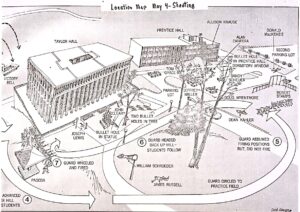 minds that their lives were in danger. Hindsight suggests that another method would have resolved the confrontation. Better ways must be found to deal with such a confrontation.
minds that their lives were in danger. Hindsight suggests that another method would have resolved the confrontation. Better ways must be found to deal with such a confrontation.
We devoutly wish that a means had been found to avoid the May 4th events culminating in the Guard shootings and the irreversible deaths and injuries. We deeply regret those events and are profoundly saddened by the deaths of four students and the wounding of nine others which resulted. We hope that the agreement to end the litigation will help to assuage the tragic memories regarding that sad day.” I agree, better ways must be found by both the protesters and the authorities.

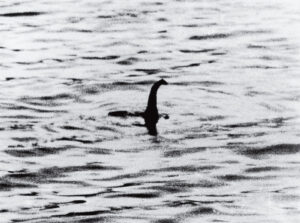 Over the years, I think most people have heard of the Loch Ness Monster. Most people have formed their own opinions as to what the monster, dubbed “Nessy” was. Many people have called it a hoax. Others have said that people imagined it. Still others thought it was a big fish or just a log. Whatever it was or is, the legend has endured for a long time now. In fact, the first “sighting” was reported on May 2, 1933. When the news broke, the newspaper, Inverness Courier told of a local couple who told of “an enormous animal rolling and plunging on the surface.” The story of the “monster” which was added by the Courier editor, becomes a media phenomenon, with London newspapers sending correspondents to Scotland and a circus offering a 20,000 pound sterling reward for capture of the beast.
Over the years, I think most people have heard of the Loch Ness Monster. Most people have formed their own opinions as to what the monster, dubbed “Nessy” was. Many people have called it a hoax. Others have said that people imagined it. Still others thought it was a big fish or just a log. Whatever it was or is, the legend has endured for a long time now. In fact, the first “sighting” was reported on May 2, 1933. When the news broke, the newspaper, Inverness Courier told of a local couple who told of “an enormous animal rolling and plunging on the surface.” The story of the “monster” which was added by the Courier editor, becomes a media phenomenon, with London newspapers sending correspondents to Scotland and a circus offering a 20,000 pound sterling reward for capture of the beast.
The sighting, which actually occurred in April 1933 sighting was reported in the newspaper on May 2nd. After that, interest steadily grew, especially after another couple claimed to have seen the animal on land. I don’t  recall ever having heard of the Loch Ness Monster being seen on land, but I suppose that if it is real, it could be seen on land too. What is really amazing, however, is the fact that the story, real, imagined, or faked, has endured through the years…90 of them to be exact.
recall ever having heard of the Loch Ness Monster being seen on land, but I suppose that if it is real, it could be seen on land too. What is really amazing, however, is the fact that the story, real, imagined, or faked, has endured through the years…90 of them to be exact.
Since the first sighting, amateur “investigators” have for kept an almost constant vigil, and in the 1960s several British universities launched sonar expeditions to the lake. None of the universities found anything conclusive, however, in each expedition the sonar operators detected something large, moving under the water. Still, they couldn’t identify the objects they saw. In 1975, another expedition combined sonar and underwater photography in Loch Ness. A photo resulted that, after enhancement, appeared to show what vaguely resembled the giant flipper of an aquatic animal. Nevertheless, the people who participated in the expeditions believed that there was something there, and they had no reason not to believe that the “monster” often called “Nessy” was real. So, the speculation continued.
In the 1980s and the 1990s, additional sonar expeditions were conducted. These also brought inconclusive 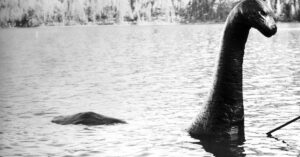
 readings. It was revealed in 1994 that the now famous 1934 photo was a complete hoax, but people still believed. It did little to dampen enthusiasm of tourists and investigators for the legendary beast of Loch Ness. The search continues to this day.
readings. It was revealed in 1994 that the now famous 1934 photo was a complete hoax, but people still believed. It did little to dampen enthusiasm of tourists and investigators for the legendary beast of Loch Ness. The search continues to this day.
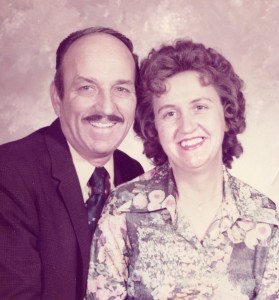 There are days when I find myself thinking more than normal about one or both of my parents, Allen and Collene Spencer, than normal, and May Day is one of the days that reminds me a lot of my mom. Mom loved the holidays, and while May Day isn’t a holiday, per se, it is a special day, and mom loved it. It was a day that she could give her girls something fun to do, while doing something fun for neighbors and friends too. Mom helped us make May baskets, fill them with candy, and told us to take them to the neighbors’ houses, hang them on the door, knock, and hide. It was the tradition of May Day, and Mom wanted us to know about it. We had so much fun making those baskets, but the real fun was in the giving of the baskets. There wasn’t a lot of candy in them. Just a few pieces, but our neighbors knew that we had left them a little bit of sweetness to brighten their day.
There are days when I find myself thinking more than normal about one or both of my parents, Allen and Collene Spencer, than normal, and May Day is one of the days that reminds me a lot of my mom. Mom loved the holidays, and while May Day isn’t a holiday, per se, it is a special day, and mom loved it. It was a day that she could give her girls something fun to do, while doing something fun for neighbors and friends too. Mom helped us make May baskets, fill them with candy, and told us to take them to the neighbors’ houses, hang them on the door, knock, and hide. It was the tradition of May Day, and Mom wanted us to know about it. We had so much fun making those baskets, but the real fun was in the giving of the baskets. There wasn’t a lot of candy in them. Just a few pieces, but our neighbors knew that we had left them a little bit of sweetness to brighten their day.

My mom was such a giving person, in so many ways. It wasn’t just May Day, or some other holiday, but really, every day. Mom gave of herself, in the kindnesses she showed, and if someone had a need, she did her best to supply that need. That was how she was raised. Her parents, George and Hattie Byer were givers, helping anyone who had a need. Their children saw that growing up, and it left a lasting impact on them too. Mom not only felt compelled to give, but she truly liked giving…from Girl Scout cookies to church to different causes she came across, Mom was a giver, and I know that she was always blessed because of it. Dad was also a giver, and they were always in agreement of these things. They taught us to be givers too, and we are all grateful for their teachings.
While May Day traditions have rather become a thing of the past, I will always remember them fondly. I think it  is sad that the May basket tradition has for the most part ceased to exist, and that makes me sad for the younger generations. Of course, with a few exceptions, most of us don’t often know our neighbors well…unless we have lived in an area for many years. Even then, people come and go, and it isn’t so easy to accept a basket of candy left on your door, unless you know for sure where it came from. It is an unfortunate side effect of the times we live in. I am thankful to have grown up in a gentler time, when May baskets could be given and received without worry about their contents, or the child giving them. Happy May Day everyone.
is sad that the May basket tradition has for the most part ceased to exist, and that makes me sad for the younger generations. Of course, with a few exceptions, most of us don’t often know our neighbors well…unless we have lived in an area for many years. Even then, people come and go, and it isn’t so easy to accept a basket of candy left on your door, unless you know for sure where it came from. It is an unfortunate side effect of the times we live in. I am thankful to have grown up in a gentler time, when May baskets could be given and received without worry about their contents, or the child giving them. Happy May Day everyone.
 I think many people realize the usefulness of a dog as something other than a pet. Over the years, there have been seeing eye dogs, service dogs, and one I hadn’t heard of before…mercy dogs. During World War I, some 50,000 dogs were “employed” by both sides of the conflict as soldiers on both sides of the conflict as mercy dogs. You might wonder just what a mercy dogs is. While it is a rather sad one, the job the dogs had was actually had a very important job in the military. During battle, these dogs were sent out to find and help wounded men on the battlefield. They were very good at their jobs.
I think many people realize the usefulness of a dog as something other than a pet. Over the years, there have been seeing eye dogs, service dogs, and one I hadn’t heard of before…mercy dogs. During World War I, some 50,000 dogs were “employed” by both sides of the conflict as soldiers on both sides of the conflict as mercy dogs. You might wonder just what a mercy dogs is. While it is a rather sad one, the job the dogs had was actually had a very important job in the military. During battle, these dogs were sent out to find and help wounded men on the battlefield. They were very good at their jobs.
On their backs, the dogs carried medical supplies. They sought out injured soldiers. If a soldier was gravely wounded, the dogs would tear off a piece of his uniform, carry it back to camp, and help other soldiers to locate the man. Sometimes, the dogs found men who were beyond saving. In that case, they lay down next to him, so that the dying soldier didn’t have to die alone. These were true acts of mercy, and these dongs had true compassion for these men.
Mercy dogs were also known as ambulance dogs, Red Cross dogs, or casualty dogs. These dogs actually served in a paramedical role in the military…most notably during World War I, but also in World War II, and the Korean War. They have been credited with saving thousands of lives. The dogs were well trained and well suited for 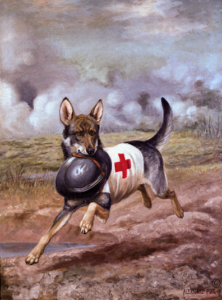 trench warfare. They were often sent out after large battles, where they would seek out wounded soldiers. They were also trained to guide combat medics to soldiers who required extensive care.
trench warfare. They were often sent out after large battles, where they would seek out wounded soldiers. They were also trained to guide combat medics to soldiers who required extensive care.
The first mercy dogs were actually trained by the German army in the late 19th century. The program to train mercy dogs in 1895 begun by Jean Bungartz in Germany was described as a “novel experiment” by those who knew about it. I’m sure they didn’t think it would actually work. Nevertheless, by 1908, Italy, Austria, and France had joined Germany in training programs for mercy dogs. Germany had around 6,000 trained dogs by the beginning of World War I. Many of the trained dogs were ambulance dogs. The German army called them Sanitätshunde or medical dogs. Germany is estimated to have used a total of 30,000 dogs during the war, mainly as messengers and ambulance dogs. Amazingly, only 7,000 of those were killed. Somehow, I would have expected there to be more deaths among the dogs. It is estimated that upwards of 50,000 dogs were successfully used by all of the nations involved in the war.
When World War I started, Britain did not have a program for training military dogs. Edwin Hautenville Richardson, who was an officer in the British Army had experience working with military dogs and had advocated for the start of a military program since 1910, but his program was not taken seriously. Nevertheless, he had trained several dogs as ambulance dogs on his own. He quickly offered them to the British Army. The army did not accept his offer, for some bizarre reason, so he gave them to the British Red Cross. As a result of his advocacy, Britain created a British War Dog School with Richardson as the commander. The school eventually trained more than 200 dogs. The British War Dog School was a grand success.

It is estimated that as many as 10,000 dogs served as mercy dogs in World War I, and are credited with saving thousands of lives, including at least 2,000 in France and 4,000 wounded German soldiers. There were several dogs that were specifically honored for their work. “Captain” was credited for finding 30 soldiers in one day, and “Prusco” for finding 100 men in just one battle. Both of these were French dogs. “Prusco” was known to drag soldiers into ditches as a safe harbor while he went to summon rescuers. Sadly, many French dogs were killed in the line of duty, and the program was discontinued. I suppose they thought it was inhumane, but I’m sure the dogs knew they were doing important work.

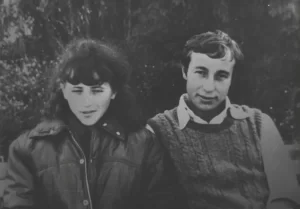 On April 26, 1986, an explosion in the Number 4 reactor of the Chernobyl Nuclear Power Plant, near the city of Pripyat in the north of the Ukrainian SSR, close to the border with the Byelorussian SSR, in the Soviet Union. So began what is considered the worst nuclear disaster in history. The Chernobyl disaster is one of only two nuclear energy accidents that was rated at seven, which is maximum severity on the International Nuclear Event Scale. The other one was the 2011 Fukushima nuclear accident in Japan, which of course, hadn’t happened yet. The cost of this disaster would be an enormous cost an estimated 18 billion roubles, which is roughly US$83 billion today. The initial emergency response and subsequent mitigation efforts involved more than 500,000 personnel. With all that, it is considered the worst nuclear disaster in history. Strange how the 4th worst disaster can also be considered the worst. I suppose it is in the cost to mitigate the damage and loss of life.
On April 26, 1986, an explosion in the Number 4 reactor of the Chernobyl Nuclear Power Plant, near the city of Pripyat in the north of the Ukrainian SSR, close to the border with the Byelorussian SSR, in the Soviet Union. So began what is considered the worst nuclear disaster in history. The Chernobyl disaster is one of only two nuclear energy accidents that was rated at seven, which is maximum severity on the International Nuclear Event Scale. The other one was the 2011 Fukushima nuclear accident in Japan, which of course, hadn’t happened yet. The cost of this disaster would be an enormous cost an estimated 18 billion roubles, which is roughly US$83 billion today. The initial emergency response and subsequent mitigation efforts involved more than 500,000 personnel. With all that, it is considered the worst nuclear disaster in history. Strange how the 4th worst disaster can also be considered the worst. I suppose it is in the cost to mitigate the damage and loss of life.
Volodymyr Pavlovych Pravyk was a Soviet firefighter, was born in the town of Chernobyl on June 13, 1962. His mother, Natalia Ivanova Pravyk, was a nurse, and his father, Pavel Opanasovich Pravyk, a construction worker. Pravyk took charge of the initial efforts to extinguish fires following the Chernobyl Disaster. I don’t know what measures were taken to protect the workers from radiation exposure, but I would expect that it was little to no protection. I would also expect that the equipment they did have was not what it needed to be to save them from radiation poisoning. After the event was over, Pravyk was hospitalized with acute radiation syndrome. For him, any improvements in protection would come too late. He died on May 11, 1986, just sixteen days later. Even though they could not save him, they knew that his actions were heroic. Pravyk was posthumously awarded the Hero of the Soviet Union and the Order of Lenin by the Soviet Union, and later the Ukrainian Star For Courage (later known as the Order for Courage) in recognition of his efforts.
It was later determined that a routine test at the power plant had gone horribly wrong, causing two massive 
 explosions that blew the 1,000-ton roof off one of the plant’s reactors. The explosions released 400 times more radiation than the atomic bomb dropped on Hiroshima. The disaster killed two workers in the initial explosions. Within months, at least 28 more would be dead by acute radiation exposure. Thousands of people would eventually show signs of health effects from the fallout, including cancer.
explosions that blew the 1,000-ton roof off one of the plant’s reactors. The explosions released 400 times more radiation than the atomic bomb dropped on Hiroshima. The disaster killed two workers in the initial explosions. Within months, at least 28 more would be dead by acute radiation exposure. Thousands of people would eventually show signs of health effects from the fallout, including cancer.
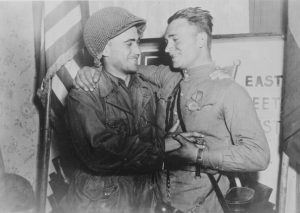 Sometimes, an event that potentially changed history, ends up getting little or no recognition. Thankfully, the picture that marked the event was taken, or the entire event might never have been noticed in history at all. This particular day is actually a very important day in the history of World War II, and therefore, the world. Elbe Day, which took place on April 25, 1945, is the day Soviet and American troops met at the Elbe River, near Torgau in Germany. This event marked an important step toward the end of World War II in Europe. If you have ever heard the saying, divide and conquer, you will know basically what happened on Elbe Day. A secret mission had been planned, and April 25, 1945, was the day it was carried out.
Sometimes, an event that potentially changed history, ends up getting little or no recognition. Thankfully, the picture that marked the event was taken, or the entire event might never have been noticed in history at all. This particular day is actually a very important day in the history of World War II, and therefore, the world. Elbe Day, which took place on April 25, 1945, is the day Soviet and American troops met at the Elbe River, near Torgau in Germany. This event marked an important step toward the end of World War II in Europe. If you have ever heard the saying, divide and conquer, you will know basically what happened on Elbe Day. A secret mission had been planned, and April 25, 1945, was the day it was carried out.
The plan was to have the Soviet army advance from the East, and the US Army advance from the West. The first contact between American and Soviet patrols occurred near Strehla exactly as planned, after First Lieutenant Albert Kotzebue, an American soldier, crossed the Elbe River in a boat with three men of an intelligence and reconnaissance platoon. Once they crossed to the east bank of the river, they met up with 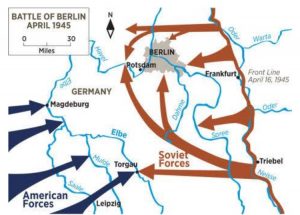 forward elements of a Soviet Guards rifle regiment of the First Ukrainian Front, under the command of Lieutenant Colonel Alexander Gardiev. Later that day, another patrol under Second Lieutenant William Robertson with Frank Huff, James McDonnell and Paul Staub met a Soviet patrol commanded by Lieutenant Alexander Silvashko on the destroyed Elbe bridge of Torgau. When the two armies connected at the Elbe River, the cutting of Germany in half is accomplished. In doing so, the strength of the German army was severely weakened. The German army was split in two, just like the country was, and in the end, that split made it impossible for the Germans to really fight the war they were engaged in. It was the beginning of the end for them.
forward elements of a Soviet Guards rifle regiment of the First Ukrainian Front, under the command of Lieutenant Colonel Alexander Gardiev. Later that day, another patrol under Second Lieutenant William Robertson with Frank Huff, James McDonnell and Paul Staub met a Soviet patrol commanded by Lieutenant Alexander Silvashko on the destroyed Elbe bridge of Torgau. When the two armies connected at the Elbe River, the cutting of Germany in half is accomplished. In doing so, the strength of the German army was severely weakened. The German army was split in two, just like the country was, and in the end, that split made it impossible for the Germans to really fight the war they were engaged in. It was the beginning of the end for them.
Finally, on April 26, the commanders of the 69th Infantry Division of the First Army (United States) and the 58th Guards Rifle Division of the 5th Guards Army (Soviet Union) met at Torgau, southwest of Berlin. They knew that this moment was monumental, and it had to be documented. Arrangements were made for the  formal “Handshake of Torgau” photo to be taken of Robertson and Silvashko the following day, April 27. The Soviet, American, and British governments released simultaneous statements that evening in London, Moscow, and Washington, “reaffirming the determination of the three Allied powers to complete the destruction of the Third Reich.” They knew they must have victory at all costs.
formal “Handshake of Torgau” photo to be taken of Robertson and Silvashko the following day, April 27. The Soviet, American, and British governments released simultaneous statements that evening in London, Moscow, and Washington, “reaffirming the determination of the three Allied powers to complete the destruction of the Third Reich.” They knew they must have victory at all costs.
The fact that Elbe Day has never been an official holiday in any country, has not stopped people from looking to the day as something very special, and in the years after 1945 the memory of this friendly encounter gained new significance in the context of the Cold War between the United States and the Soviet Union.
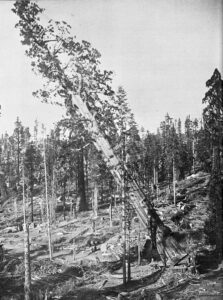
 If you have ever wondered about the stupid things people can do, consider this. Most people have heard about the Redwoods in California. Trees just seem to grow much bigger in California, and if you have ever toured the Redwood National and State Parks, you will know what I mean. There is also a Sequoia National Park, and bordering that the Kings Canyon National Park, which was the location of the Mark Twain Tree…a giant sequoia tree located in the Big Stump Forest of Kings Canyon National Park. The giant tree was named after the American writer and humorist Mark Twain. The tree stood 331 feet tall and stretched 16 feet in diameter. It was an amazing tree, but there were people back East and in Europe who did not believe that trees could grow that big. In the late 1800s, travel across the country or from Europe just to see a big tree, was apparently not feasible. Now, I get that it could be difficult, and I get that the government wanted to prove that the tree existed, but what they did was no more than a display of stupidity.
If you have ever wondered about the stupid things people can do, consider this. Most people have heard about the Redwoods in California. Trees just seem to grow much bigger in California, and if you have ever toured the Redwood National and State Parks, you will know what I mean. There is also a Sequoia National Park, and bordering that the Kings Canyon National Park, which was the location of the Mark Twain Tree…a giant sequoia tree located in the Big Stump Forest of Kings Canyon National Park. The giant tree was named after the American writer and humorist Mark Twain. The tree stood 331 feet tall and stretched 16 feet in diameter. It was an amazing tree, but there were people back East and in Europe who did not believe that trees could grow that big. In the late 1800s, travel across the country or from Europe just to see a big tree, was apparently not feasible. Now, I get that it could be difficult, and I get that the government wanted to prove that the tree existed, but what they did was no more than a display of stupidity.
So, the solution was hatched. In 1891, the US Army arrived in California. Their mission was simple. Cut down 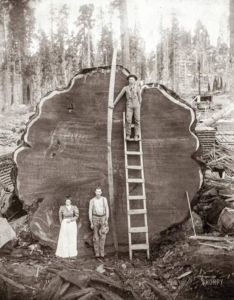 the famous Mark Twain tree so that slices of it could be sent to the American Museum of Natural History. In what is now Kings Canyon National Park, soldiers approached the giant sequoia tree and promptly cut it down. The tree, well known as it was, inspired wonder and doubt from those who had heard about it. Slices of the Mark Twain Tree were sent back to the East Coast and Europe, where it was displayed at museums in New York and London.
the famous Mark Twain tree so that slices of it could be sent to the American Museum of Natural History. In what is now Kings Canyon National Park, soldiers approached the giant sequoia tree and promptly cut it down. The tree, well known as it was, inspired wonder and doubt from those who had heard about it. Slices of the Mark Twain Tree were sent back to the East Coast and Europe, where it was displayed at museums in New York and London.
The project took 13 days and was carried out by lumbermen Bill Mills and SD Phips, with assistance from Barney and John Lukey. The tree was later shipped to the American Museum of Natural History in New York and the British Museum in London at the expense of Collis P Huntington, the president of the Southern Pacific Railroad. I suppose it is easy enough to understand why people couldn’t believe the huge trees were real. And for the Sequoia trees, even though the Sequoia National Park was established in 1890, access to the sequoia groves was difficult and the existence of such large trees was not widely believed at the time. I suppose some people might think that could justify the actions of the US Army and the US government, but to me it was a travesty, and a complete display of stupidity. So, to prove the tree could grow that big, they killed it, so they couldn’t see how big it could really grow. All to prove a point, 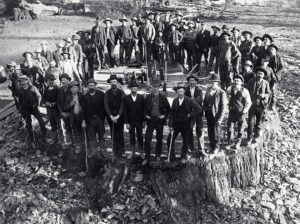
 because there were those who thought the story was bogus.
because there were those who thought the story was bogus.
Today, you can see the Mark Twain stump, and the other remains of the tree, which are preserved as part of the Big Stump Picnic Area in Kings Canyon National Park. The stump is near the entrance to Grant Grove. The stump stands there as a monument to the stupidity of some men.

 Born in Uruguay 1840, Ramon Artagaveytia was an Argentinian businessman. Even in 1840, businessmen had a need to travel periodically. That is why Artagaveytia found himself on board the ship America when it sank in December 1871. I’m sure the situation was absolutely terrifying, but Artagaveytia, became one of just 65 passengers to survive the disaster. He survived, only by jumping into the water and swimming to safety. I’m sure he felt very fortunate to survive his ordeal, but that is not to say that he was not traumatized. For years, Ramon Artagaveytia, was terrified of travel. Still, while he may have limited his travel, it was still essential at times.
Born in Uruguay 1840, Ramon Artagaveytia was an Argentinian businessman. Even in 1840, businessmen had a need to travel periodically. That is why Artagaveytia found himself on board the ship America when it sank in December 1871. I’m sure the situation was absolutely terrifying, but Artagaveytia, became one of just 65 passengers to survive the disaster. He survived, only by jumping into the water and swimming to safety. I’m sure he felt very fortunate to survive his ordeal, but that is not to say that he was not traumatized. For years, Ramon Artagaveytia, was terrified of travel. Still, while he may have limited his travel, it was still essential at times.
All that changed in 1912, when he wrote a letter to one of his cousins. In his letter, Artagaveytia, expressed relief, saying, “At last I will be able to travel, and, above all, I will be able to sleep calm. The sinking of the America was terrible!… Nightmares keep tormenting me. Even in the most quiet trips, I wake up in the middle of the night with terrible nightmares and always hearing the same fateful word: ‘Fire! Fire! Fire!’… I have even gotten to the point where I find myself standing in the deck with my lifebelt on….”
Artagaveytia was returning to the Americas, following a visit with his nephew in Berlin. As it turned out, the ship that finally put his mind at ease, was the “unsinkable” Titanic. When Artagaveytia arrived at Titanic, he was awed by its luxury. Everyone who saw Titanic was awed by its luxury. For Artagaveytia, one of Titanic’s greatest features was the fact that the ship had telegram capabilities. The promise of instant communication should a crisis arise, brought Artagaveytia great comfort.
Of course, as we all now know, Titanic would not be the ship that would make him safe. Titanic was simply not “unsinkable” because no ship is unsinkable. Titanic would hit that iceberg hiding in the darkness on April 14, 1912, and it would sink, in the early hours of April 15, 1912. Artagaveytia was reportedly seen on one of the decks of Titanic with two fellow passengers, looking as though he wasn’t concerned about the ship actually 
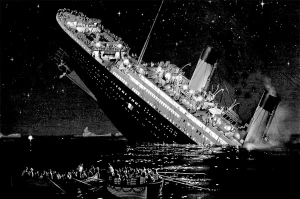 sinking. He had accepted the story that so many people had believed…that somehow, this ship was “unsinkable.” Somehow, he and many others trusted the story above what should have been understood a known fact…that any ship can sink. This time, Artagaveytia would not escape. Artagaveytia’s body was found in the North Atlantic roughly one week after the ship sank to the bottom of the sea.
sinking. He had accepted the story that so many people had believed…that somehow, this ship was “unsinkable.” Somehow, he and many others trusted the story above what should have been understood a known fact…that any ship can sink. This time, Artagaveytia would not escape. Artagaveytia’s body was found in the North Atlantic roughly one week after the ship sank to the bottom of the sea.

